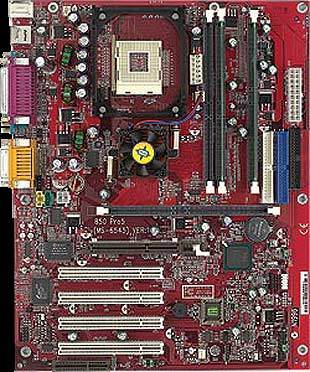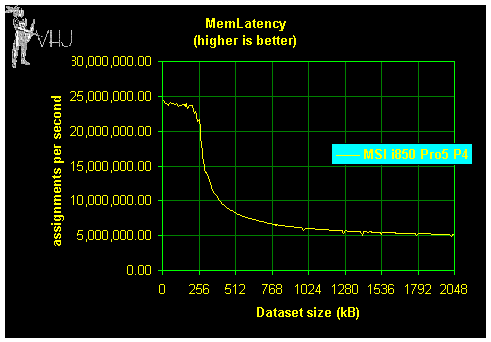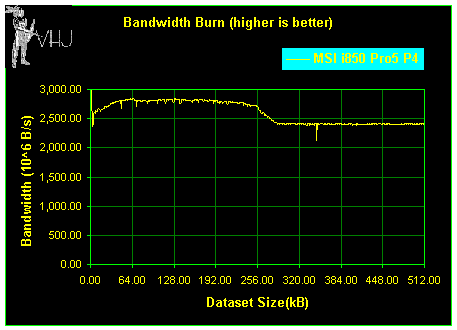
The MSI i850 Pro5
By Joel Hruska
Date: December 3rd, 2001

The MSI i850 Pro 5 is the latest i850 Socket-478
motherboard from MSI, and, like the other MSI boards
we've examined, it proves itself as a very stable, well-rounded, P4 solution.
The Pro 5 also comes in about ten to fifteen dollars cheaper than some of the
other available i850 solutions. The board still manages to provide a full
feature set even at a lower price point, however, and includes the following:
● Support for up to 2 GB of RDRAM
● Onboard CMI 8738 Audio (superior to the standard AC97 Codec)
● 4 PCI / 1 CNR slot
● Support for Socket-478 P4's from 1.3 to above 2 Ghz.
===================================
Fun With Heatsinks
One place where AMD has taken a fair amount of heat [ed: punny, Joel] since the
Thunderbird debuted has been their heatsink design and placement. Most AMD
heatsinks require a great deal of force to clip properly to a motherboard and
although its rare, its not unheard of for a CPU core to get damaged during the
attachment process. Its also possible to kill a motherboard with a slip of a
screwdriver during mounting or unmounting a heatsink-and I speak from experience
on this one.
I'd heard about the new Intel method of mounting P4 heatsinks and was curious to
see what they'd developed. As you can see in the above picture, the CPU (which
is tiny-Socket 478 P4's are in a MUCH smaller overall package than an Athlon,
though the P4's Willamette die, at 217 square millimeters, remains much larger)
is surrounded by a huge plastic mount. That entire mount is for the heatsink-which
is massive enough to put any AMD heatsink + fan to shame.
The good news is that the entire affair is easy to attach. I had no problems
clamping the heatsink on and it locking it into place smoothly.
The bad news is, that clamp exerts enough force to physically bend the
motherboard upwards several degrees. It's not an extreme tilt, but its easily
visible to the naked eye, and it's a development I definitely don't like. While
I realize fiberglass is a reasonably flexible material, I'm also aware that
there are a number of very small traces running through that fiberglass-and if
the board manufacturer had intended them to be bent, I'm sure he'd have designed
the motherboard that way. [ed: Motherboards sound like Rice Krispys with all
the snapping, crackling and popping when the P4 heat sink lever is engaged.]
As far as I'm concerned, both Intel and AMD have a ways to go with their cooling
designs. I don't think its too much to ask for AMD cooling solutions that don't
require me to put the same amount of torque on a heatsink as I normally would to
loosen a lug nut. Similarly, I'd prefer my Intel solutions to not bend my
motherboard upwards. MSI built the thing straight-we can assume they did it for
a reason. So how about it guys?
===================================
Board Stability and BIOS
features
The board itself was completely stable during our installation of WindowsXP and
subsequent rounds of benchmarking, with only one odd flaw: Whenever we entered
the "PC HEALTH" section of the BIOS the machine would freeze after a few
seconds. This always occurred and a BIOS flash failed to fix the issue.
CPU temps were well within limits at all times and we were unable to explain
this error. It occurred even after numerous CMOS resets.
Apart from this odd flake, the board was stable. The AWARD BIOS offers the usual
range of features and switches, including separate options for raising the FSB
and CPU voltage. I was disappointed that no options to adjust RDRAM timing or
I/O voltage were available, although the board does support RDRAM frequencies of
300 or 400 Mhz. Our board proved capable of running a 133 MHz FSB (533
quad-pumped) though our RDRAM wasn't stable past 105 MHz (x4).
===================================
The i850's Odd
Positioning
Although the MSI Pro 5 is an excellent board, the i850 chipset itself is in a
bit of an odd position. When it debuted, the i850 was the only P4 solution
available, making it the default choice. The SDR version of the i845 never
challenged the i850 in terms of performance. Up until recently, an i850-based
motherboard was the only choice for a customer that wanted a high-performance P4
platform with a large variety of motherboard types to choose from.
This is no longer true, however. The VIA P4X266 performs similarly to the i850
and offers DDR support. The somewhat scarcer SiS 645 chipset features DDR333
support and actually surpasses the i850 board, while both ALi and Intel have
their own upcoming P4 DDR solutions. Intel's i845 DDR solution is widely
expected to offer excellent performance and it's doubtful that ALI's own product
will be far behind. With VIA supposedly in talks with Intel to gain access to an
official P4 chipset license, the P4 chipset market has both moved decisively
towards DDR and gotten very crowded very fast.
Now that Intel has cancelled the advanced RDRAM "Tulloch" chipset the future of
RDRAM for the P4 looks questionable [ed: and the rumors of an Athlon chipset
simply make no sense given the AMD chip's line size and architecture]. SiS has
licensed RDRAM from Rambus which some are now
claiming
was part of their licensing agreement with Intel . Given the fact that RDRAM
continues to command a substantial price premium over DDR-RAM, offers little to
negative performance advantages and carries the black history of Rambus, there
are precious few reasons to invest in an i850 motherboard today.
None of this, however, is MSI's fault. They have taken the Intel i850 chipset
and built a low-priced, stable, and high-performance motherboard from it. If you
already own RDRAM and are looking to re-use it-or, if you only trust Intel
chipsets, want high performance, and refuse to wait for i845 DDR-the MSI Pro 5
i850 is an excellent choice.
===================================
Benchmarks
Testbed Configuration
Pentium 4 2 GHz
MSI Pro 5 i850 Motherboard
WindowsXP
256 Meg RDRAM
Seagate Barracuda ATA IV
Gainward GeForce3 Ti 500
===================================
Sysmark 2000: 1024x768x32
Our P4 2 GHz turns in a score of 258 in Sysmark 2000, which is within expected
values for a P4 2 GHz in general. Sysmark 2000 is less bandwidth dependent and
more processor-dependent than its younger brother, Sysmark 2001, but many of the
apps used in Sysmark 2000 are still generally used in many businesses, making it
a pertinent package to evaluate with.
Unfortunately our P4 refused to complete a run of Sysmark 2001, always bombing
out in the same spot in the Office Productivity benchmark after all patches were
installed. The benchmark's homepage, however, states that it is not to be run
with WindowsXP, and as we've used it without incident in 2K we believe this may
be an XP glitch-not a motherboard fault.
===================================
3DMark 2001: 1024x768x32
The P4 performs excellently in 3DMark 2001 with a score of 7554, but this is to be expected. 3DMark
2001 is a very bandwidth-sensitive benchmark (and the P4's 400 MHz bus provides
a high-bandwidth solution) and when combined with a top-of-the-line GeForce3 Ti
500, it'd be difficult for any high-performance system to turn in a bad score.
===================================
3DMark 2000: 1024x768x32
3DMark 2000 is getting a bit long in the tooth, but is still worth looking at.
None of the game engines or situations modeled in 3DMark2000 are going to take
advantage of the P4's specialized SSE2 instruction sets or are optimized for
high bandwidth. By that same token, however, all of the game engines and
scenarios modeled here were designed for older hardware and even without its
optimized code, the P4 turns in a score of 9,557.
===================================
Quake 3: Arena 1024x768x32
In Quake 3 the P4 again performs typically on the MSI platform and within
expectations. It is rather funny, however, to note that 168 fps in Q3A in
1024x768x32, all detailed maxed is "within expectations." It was only about 18
months ago that a video card that broke 60 fps in Quake 3 under these settings
was amazing.
===================================


===================================
Conclusion
The test results of the MSI i850-based motherboard are solid. The board performs
at the top of its class and represents a reliable and powerful P4 solution that
costs a few dollars less than the average RDRAM motherboard. Given that MSI is a
first-tier company with an excellent record in stability, service, and support
we feel comfortable recommending the Pro 5 for those looking for an RDRAM-based
Intel Pentium 4 Socket 478 motherboard.
===================================
Pssst! Our Shopping Page has been updated.
===================================